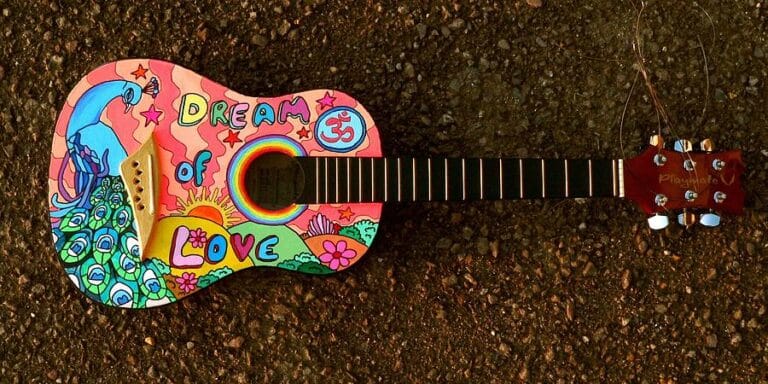Last Updated on May 12, 2022 by IDS Team
Note – this article is not necessarily intended as a guide to the specific pedals out there on the market or used by musicians. Instead, it gives a deeper look into the mechanics of each of these kinds of effects – how they work to create the sounds that they do, and how this in turn shaped the musical era when these became popular- both in the public imagination and in the way guitarists continue to use them today. Any of these kinds of pedal can be found in both digital and analogue form, with digital pedals for sound design altering the wave form in a very similar way to their analogue counterparts.
The two decades spanning the 1960s to the 1970s were a seminal and pioneering period of music. As society became less restrictive, all forms of new subcultures were born. Beginning with The Beatles, who took a strong influence from Indian ragas – and ending with Jimi Hendrix and Led Zeppelin, in this period music technology saw exponential growth in response to changes in demand by the music industry. Luthiers, technicians, and electronics specialists were able to showcase their skills with the design of new sounds and repurposing of old sounds.
These new sounds led to musicians redefining what it meant to play guitar. Sound recordings became increasingly complex, and memorabilia from the era has become prized within the market. Conjuring up vistas of the desert areas of California, with their rocky outcrops, stunning saguaro cacti, and the backdrop to many a Hollywood movie, guitarists in the sixties were all about distorting the sound of the original note through effects which aimed as much for edgy rebellion as for a mellow, rich, soulful tone with plenty of harmonics and different layers. Jimi Hendrix is one of the most notable as he held the stage through the raw feeling of his distorted version of the Star-Spangled Banner. Below are some of the pedals which became popular within the era – and a guide to their internal mechanisms for anyone curious about the creation of its signature sounds.
Wah
This pedal was most famously used by Hendrix – and is designed to make a crying sound come out of the guitar. Wah pedals work by adding a filter to the original sound which is controlled when the pedal is activated, as well as by controls which may vary from pedal to pedal. As a result, parts of the soundwave are chopped off, boosting the midrange, and excluding the extremities to make the guitar sound as if it has literally developed a voice of its own. This mid-range boost is a very characteristic part of its technology, mellowing out the sound- making it richer, fuller, and more human. On any DAW, the wah pedal is one of the most commonly included pedal in any FX library, due to its popularity and versatility.
Fuzz
The fuzz pedal – another characteristic sound of the sixties and seventies desert rock era – uses a phenomenon called clipping to create a very different kind of distortion from both wah pedals and the myriad overdrive pedals available on the market. This means that so much gain is applied to the signal that it distorts, hitting a threshold which essentially causes the soundwave to double back on itself and overlap, causing a very grainy, thick sounding wall of noise. Whilst clipping is undesirable in the mixing and mastering process, within a fuzz pedal, all runs smoothly based off a very simple circuit and the resulting sound is much softer than the process within the mechanics might suggest. In fact, this is one of the gentler forms of guitar distortion, used by pop rock bands all throughout the sixties and seventies but also perfect for the slower ballads of harder rock acts. Like the wah pedal, the fuzz pedal is a staple of pretty much all DAWs, and there are plenty of options.
Tremolo
Tremolo bars became a characteristic feature of classic American rock ‘n’ roll towards the end of the era as guitar effects moved on in their sophistication. As rock music became more complex and the solos contained higher and more intense riffs, tremolo bars were favoured to give a ‘wobbly’, distorted sound to high notes.
Tremolo can refer to both the tremolo or whammy bar – which is a feature on certain kinds of guitar – as well as to tremolo pedals, which use very small, frequent alterations in either pitch, volume, or both to create a vibrato effect. Both square and sine waves distort the original signal differently, with distortion in this case referring to a way of altering the notes, which is different to the emphasis of undertones, overtones, and overlapping waves in fuzz, wah, and overdrive pedals. Therefore, they are invaluable for cleaner solos and different sounds when rock or metal guitarists want to take a break and go clean again. A tremolo is easily found on many FX plugins on DAWs such as Logic and Ableton.
Distortion/Overdrive
Classic distortion is one of the most recognisable sounds of the era, and music legend has it that it first became a significant part of rock history when the Rolling Stones stomped on their amps to record their now classic song (I Can’t Get No) Satisfaction. As a result, millions of other artists craved the sound which set them apart and provided a sense of edgy rebellion against the puritanism, clean sounds and lyrics of the fifties as middle America really came into being. The distorted sound became synonymous with music which set its listeners apart a little bit. It’s not hard to find distortion/overdrive on any DAW – and the multitude of choices means there is something for everyone, though as a result careful consideration is needed to find the perfect sound for your track.
Phaser
This pedal is most synonymous with the early seventies when Led Zeppelin began using it in their guitar solos to great effect. During this time, rock music began getting heavier. The phaser pedal is one which creates a sweeping sound by filtering the original signal via a sound processor. It has a series of peaks and troughs in its frequency attenuation graph, and thus when the positions of the peak’s changes, it makes the original note sound as if it is sweeping up and down due to the constantly changing frequencies within the pedal’s filter. As a result, this can be used to great dramatic effect. Phaser plugins range from state of the art to basic and can be found for all styles of guitar from psychedelic rock ‘n’ roll to heavy metal.
How have these sounds become associated with the Californian desert and how have they been repurposed for today?
Every era of music has its distinctive and characteristic sounds, but these sounds are some of the most evocative of a particular place and time because of the emotional and historical significance of the music which was created there. The Rolling Stones, Led Zeppelin, and Jimi Hendrix were pioneers of the music which shaped the minds and hearts of the youth at the time as well as bands such as Deep Purple, America, and earlier bands such as The Beatles and the Mamas and the Papas- and which for many who remember the era, this music still holds an extremely special place due to the memories of freedom and rebellion associated with it.
The Californian Desert was also the location of many historical festivals such as Woodstock – and saw the birth of musical get togethers which are still going on to this day. As a result, it is sometimes impossible to think of this era without also recalling the desert sounds and mesa outcrops which painted the backdrop to these festivals. Even to this day, the branding and decoration of some of these evokes the period with psychedelic lettering and bold colours, and the types of pedals in this article are perfect for bringing this era back to life or repurposing it’s sounds.



